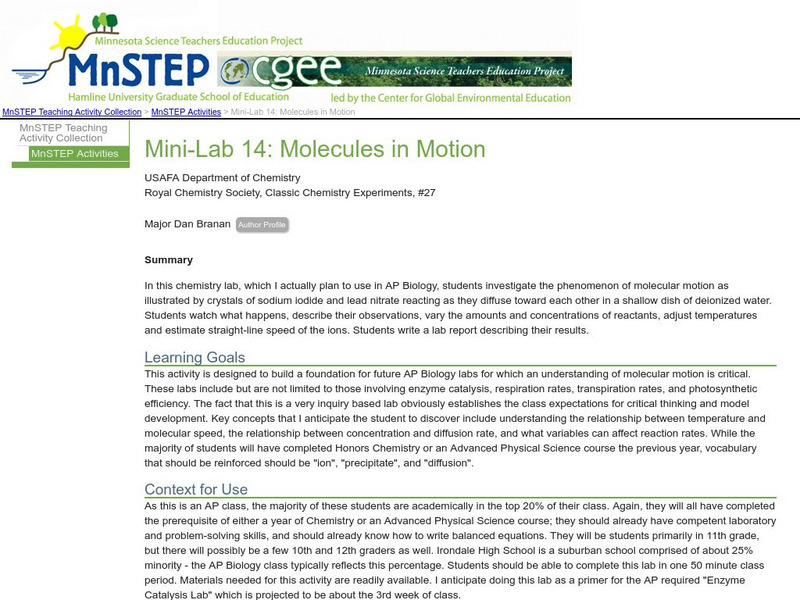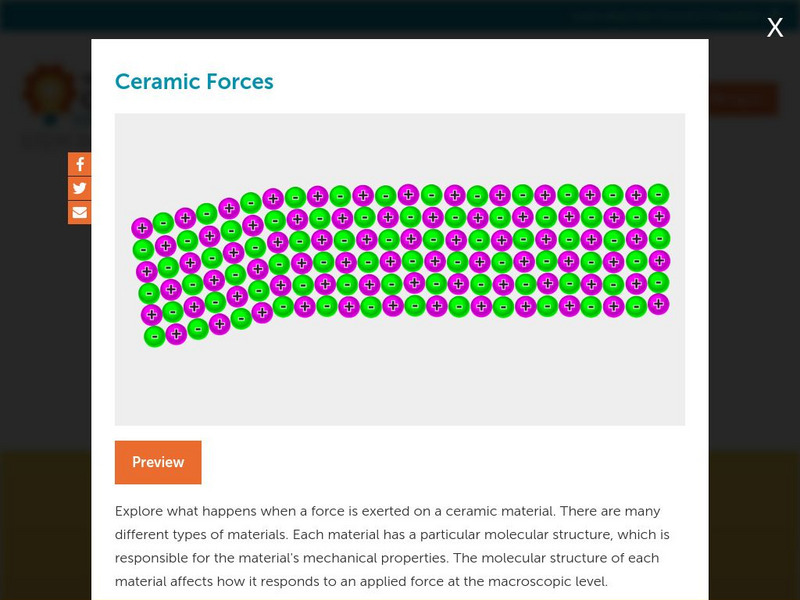Concord Consortium
Concord Consortium: Molecular View of a Gas
This simulation allows students to make observations about the structure and movement of particles in a gas.
Concord Consortium
Concord Consortium: Molecular View of a Liquid
This simulation allows students to make observations about the structure and movement of particles in a liquid.
American Chemical Society
Middle School Chemistry: Heating and Cooling a Liquid
This simulation allows students to make observations about how particle motion changes as the overall temperature of a liquid changes.
CK-12 Foundation
Ck 12: Temperature
[Free Registration/Login may be required to access all resource tools.] In this interactive tutorial students will learn the physics definition of temperature, how temperature is measured and how to convert the units of temperature...
Discovery Education
Discovery Education: 3 M Young Scientist Lab: Water Jug Race
First one to empty the jug wins! And it's not as easy as it sounds...
Science Education Resource Center at Carleton College
Serc: Mini Lab 14: Molecules in Motion
In this inquiry-based lab, learners investigate the phenomenon of molecular motion. They will understand the relationship between temperature and molecular speed, the relationship between concentration and diffusion rate, and what...
Science Education Resource Center at Carleton College
Serc: Visualizing Molecules in Motion
In this lab, students will explore the motion of molecules, the forces involved in making them move and predict the level of interaction that molecules can have in order to better understand chemical reactions.
Simon Fraser University
Chem1 Virtual Textbook: Some Consequences of Random Molecular Motion
The General Chemistry Virtual Textbook, or Chem 1, is broken into several sections covering various aspects of topics related to chemistry. This section deals with random molecular motion and topics such as diffusion and effusion.
Purdue University
Purdue Univ: Gases, Liquids, and Solids
This site has a brief description of the differences in particles in a gas, liquid, and solid. Animated microscopic pictures demonstrate the molecular movement in each state. Information is then summarized in an easy-to-read chart.
TED Talks
Ted: Ted Ed: The Invisible Motion of Still Objects
Ran Tivony describes how and why molecular movement occurs and investigates if it might ever stop. [4:44]
Other
Einstein Archives Online
Online access to portions of Einstein's original papers and manuscripts.
American Chemical Society
Middle School Chemistry: Density of Water
Discover how the molecular make-up of water affects its density.
American Chemical Society
Middle School Chemistry: Temperature and Density
Learn how the molecular movement in different temperature water affects the density of the liquid.
Concord Consortium
Concord Consortium: Ceramic Forces
Explore what happens when a force is exerted on a ceramic material. The molecular structure of the material affects how it responds to an applied force at the macroscopic level.
Concord Consortium
Concord Consortium: Metal Forces
Explore what happens when a force is exerted on a metallic material. The molecular structure of the material affects how it responds to an applied force at the macroscopic level.
Concord Consortium
Concord Consortium: Plastic Forces
Explore what happens when a force is exerted on a polymeric plastic material. The molecular structure of a material affects how it responds to an applied force at the macroscopic level.
Concord Consortium
Concord Consortium: Tire Forces
Explore what happens when a force is exerted on a rubber tire. The molecular structure of each material affects how it responds to an applied force at the macroscopic level.
Concord Consortium
Concord Consortium: Phase Change
In this activity, students explore phase change at a molecular level. (Requires Java)
Concord Consortium
Concord Consortium: Heat and Temperature
Learn that temperature measures average kinetic energy, and heat is the transfer of energy from hot systems to cold systems. Consider what makes a good conductor. (Requires Java)
The Wonder of Science
The Wonder of Science: Ms Ps1 4: Thermal Energy and Particle Motion
Work samples, phenomena, assessment templates, and videos that directly address standard MS-PS1-4: thermal energy and particle motion.
American Chemical Society
Middle School Chemistry: Molecules Matter
Explore molecular motion and attraction, and see how those phenomena affect the matter they comprise.
OpenSciEd
Open Sci Ed: Net Logo: Gas Particle Collisions Up Close
This simulation explores the relationship between particle kinetic energies during particle collisions.
OpenSciEd
Open Sci Ed: Net Logo: Gas Particle Motion and Temperature
This simulation explores the relationship between the temperature of a gas, the motion of the particles in the gas and the changes in the kinetic energies of particles during collisions.
CK-12 Foundation
Ck 12: Chemistry Simulation: Building Bridges
[Free Registration/Login Required] Learn about temperature and molecular motion and why they are important to consider when building a bridge.















